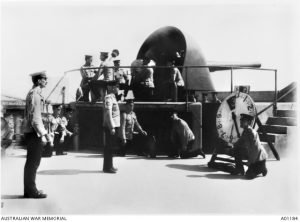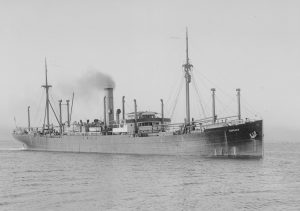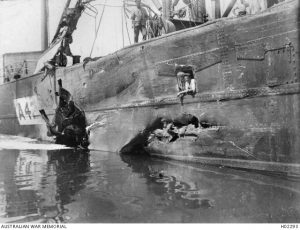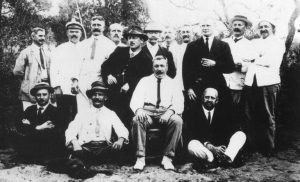- Author
- A.N. Other
- Subjects
- Ship histories and stories, History - WW1
- Tags
-
- RAN Ships
- None noted.
- Publication
- September 2014 edition of the Naval Historical Review (all rights reserved)
By Jim Craigie
In August 1914, Germany was second only to Britain in merchant tonnage. In the Pacific, German territories and international trade meant German merchant ships were frequent visitors to British Empire ports with numerous supplies needed by German settlers in New Guinea coming from Australia. On 3 August there were many German merchant ships in Australian ports. Just one of them was the SS Pfalz, operated by Norddeutscher Lloyds of Bremen. Her master, the young Captain Wilhelm Kuhleken, was destined to hear the first shot fired on this side of the world in World War I.
The name Pfalz is a diminutive of the ancient south-western German province of Rheinland-Pfalz. SS Pfalz was a new ship of 6,557 tons built in 1913 by the renowned shipyard of Bremer Vulkan. The type of plating used in German shipyards at that time was thought to add great strength and Pfalz was said by her builders to be the finest of her type in the world.
Australian authorities were well aware that German ships would run for it if war was declared. On 2 August the Director of Naval Reserves was ordered to take immediate steps to put into force an ‘Examination Service’ in all defended ports. Accordingly at Thursday Island, Brisbane, Newcastle, Sydney, Melbourne, Adelaide, Fremantle and Hobart every vessel entering and leaving those ports anchored in an area set apart for the purpose and submitted to examination by the naval authorities. The coastal pilots of Australia were mobilised for the task.
Despite the pilots’ readiness the nation’s top politicians were distracted, being enmeshed in a fierce general election campaign called because Labor senators were frustrating the will of the Liberal majority in the House of Representatives. Prime Minister Joseph Cook was campaigning in Ballarat and other country centres. At last Cook received the message that war was imminent and as many of the Cabinet that could be gathered together met on 3 August and pledged full backing for Britain.
At the end of July 1914 the agent and captain of SS Pfalz, were aware that hostilities were threatening and had her ready for sea on the evening of 4 August; ostensibly she was bound for Sydney, but actually it was intended to take her to a South American port. At the last minute her departure was delayed to take on an additional 200 tons of coal. This was loaded during the night of the 4th. Early next morning the vessel left her moorings but traffic on the Yarra delayed her in getting clear of the river. She steamed slowly, her captain having resolved to conserve his coal, in the charge of Captain Robinson of the Port Phillip Pilot Service.
When Pfalz arrived off Portsea at about 1000 a launch came alongside with an officer of the Examination Service. The ship was examined, but advice of the outbreak of war had not been received and so there was no legitimate reason to stop her and she was given approval to proceed. Some German consular officials, who had not previously made their appearance on deck, came on to the bridge and they and the ship’s captain displayed great jubilation. Meanwhile the vessel had turned on the tide and Captain Robinson was engaged in swinging her round.

Between the departure of the Examination Service launch from the Portsea jetty to inspect Pfalz and its return, advice of the outbreak of war had reached the heads. It was Solicitor-General Sir Robert Garran who issued the order to fire the first shot of the war on 5 August 1914. LTCOL Sandford at Fort Queenscliff passed on the order to LT Morris, Fire Commander at Fort Nepean, to ‘stop her or sink her’.
The order was telephoned to Fort Nepean and signals were hoisted calling on the vessel to stop. But Captain Robinson was concentrating on getting her through the heads. A glance at the map of Port Philip Bay shows how close to open water the vessel was. The first realisation Robinson had that all was not serene was the booming sound from one of the Fort Nepean guns, followed by the splash of the shell close to the Pfalz’s stern (not the customary shot across the bow). He immediately signalled to the engine room ‘full speed astern’. The Captain at once countermanded with ‘full speed ahead’.
For a time pilot and master struggled for control, Captain Robinson explaining to the German that it was useless to resist, as the next shot would hit his vessel. With great reluctance the Captain submitted. The rapid change from elation to the realisation of certain capture must have been very trying to a young officer with his first command.
Pfalz was brought back to Portsea where both ship and crew were placed under arrest. Shortly afterwards she was taken to Williamstown by Captain Robinson and remained there about five months when the Commonwealth Government claimed her as a prize and converted her into a troopship.
The crew of the Pfalz was sent to Holsworthy internment camp and Captain Kuhleken and his officers to Berrima where they remained until hostilities ceased. But this ship was to go on to have an eventful war.
Boorara’s big adventure
Pfalz was converted to a troop transport at Williamstown and renamed His Majesty’s Australian Transport (HMAT) Boorara, with the pennant number A42. Boorara is a Western Australian gold mining area. She then sailed for Sydney. A fleet of transport ships was leased by the Commonwealth government for the specific purpose of transporting AIF formations to their respective overseas destinations. When not committed to military transport, these ships were employed to carry various commodity exports to Britain and France. The fleet was made up of British ships and captured German vessels.

HMAT Boorara left Sydney on 21 December carrying 114 troops and 387 horses and joined the Second ANZAC Convoy at Albany. She safely landed troops and their mounts in Egypt and went on to London with other cargo. Instead of returning to Australia she was temporarily taken over by the Admiralty for cross-channel work and later sent to the Mediterranean to run as a storeship between Alexandria and Mudros, a small port on the Greek island of Lemnos. It gained wartime significance in the early part of 1915 with the determination of the Allies – largely through the enthusiasm of Winston Churchill –in an attempt to seize control of the Dardanelles Strait, some 50 km away.
In mid-July 1915 Boorara was involved in the evacuation of Turkish prisoners of war and taking them under guard to internment in Egypt. Shortly after midnight on 17 July the master (Captain McPhail) had shaped his course to pass to the east of Skyros Island, when a shout from the officer on the bridge brought him from his chart. The first thing he observed was a large vessel, without lights, bearing down upon him at great speed on the starboard side. Boorara was struck aft between No. 5 and 6 hatches with the other ship wedged in her hull. All hands were immediately ordered to emergency stations and Captain McPhail requested the stranger – which turned out to be the French armoured cruiser Kleber – not to back out until the Turkish prisoners and their guards, and a portion of his crew could make their way to safety onboard the cruiser. Number 5 and 6 holds were rapidly filling with water, the influx being beyond the control of the pumps.

The light cruiser HMS Doris and an armed boarding steamer Fauvette stood by and as the Boorara appeared to be settling down, the remaining hands left her. However as she did not sink, within half an hour the master and those of the crew who had boarded Doris returned to the ship. They were able to get underway and she arrived at Mudros Harbour about 1400. The only casualty was one missing steward.
So severe was her damage that after temporary repairs were affected Boorara was docked at Naples for several months. In May 1916 she left for Australia with a cargo of sulphur from Sicily. In mid-August she embarked 1,100 troops at Brisbane and Sydney for England, and lifted wheat and other cargo for Bordeaux and London. At Bordeaux congestion was so great she had to wait 30 days for a berth. For most of the next two years she continued in her role as a troopship and a storeship taking both troops from England and troops from Australia to the Middle East.
At 1135 on 20 March 1918, while making a zigzag course down the English Channel to Plymouth, where she was to embark passengers for Australia, she was attacked off Beachy Head lighthouse by submarine UB3, whose torpedo blew a hole 40 by 22 feet in her port side abreast of the funnel. The engine room was immediately flooded and the engines stopped working.
Five men were lost. The fourth engineer escaped through being floated up the engine room ladder by the inrush of water. Wireless warnings were sent out. After quickly ascertaining the damage the master (Captain Buchanan) believed it might be possible to tow the ship into Portsmouth instead of beaching her on the exposed coast. He therefore ordered all hands not required in the towing operation to be put off in boats. Two armed trawlers which had come to her assistance readily agreed to undertake the tow.

By 1300 five trawlers were involved in towing and at 1500 a tug arrived. A naval officer boarded and suggested she be taken to Southampton. A thick fog set in and she twice ran aground. It was not until 0800 on 22 March she was beached off Netley. The ship, patched up, was ordered to the Tyne for full repairs. She left Southampton on 17 July towed by two tugs and next morning picked up a trawler escort. After anchoring for three nights through unsettled weather she put out again on 22 July.
Off Whitby at 1300 on 23 July the track of a torpedo from German submarine UC70 was sighted by several crew. It struck her in the same spot as the previous torpedo. The explosion buckled the ship badly, but the tugs were signalled to continue towing. Two hours later as she was making little or no water, Captain Buchanan decided to go to the Tyne as ordered. Her officers and crew working unsparingly, she arrived off the Tyne at 2030, securing to a mooring two hours later. The next day, when she went into dry dock, it was seen that the ship had nearly broken in two, and that both main and auxiliary engines were completely wrecked. It was July 1919 before new engines were installed and repairs effected, and she returned to the Commonwealth with Australian troops.
Research shows that after the war Boorara was used by the Commonwealth Line for the transport of frozen cargo to the United Kingdom, using ports at Avonmouth, Liverpool and Glasgow. In 1926 she was acquired by the Hadjilias shipping line of Athens and renamed Nereus. In August 1937 Nereus sailed in ballast from Moji in Japan for Port Alberni to load a cargo of lumber for the United Kingdom under charter to the Anglo-Canadian Shipping Co. On 8 August in heavy fog she ran aground on rocks about 300 m south-east of Cape Beale on Vancouver Island. The salvage steamer Salvage King from Victoria rescued her crew. Within 48 hours of grounding, Nereus broke her back and was lost.
Of course many other Australian ships had similar adventures in WW I – the Pfalz stands out for that shot from Port Nepean. As for Captain Kuhleken, he returned to Bremen after four and a half years of internment. But he didn’t forget Australia. In 1930 he returned as master of the Grandon. His main aim was to meet again Sergeant-Major Leonard Hagon from Berrima. ‘Ever since the war ended I have wanted to get back to Australia but I never saw a chance until the Grandon was listed. I promptly resigned a better command and applied for this ship. My friends thought I was mad but I longed for another sight of Berrima and especially I wanted to meet again my friend Mr Hagon, whom I will always regard as my friend’.
They caught up in Melbourne and then Captain Kuhleken went on to Berrima. ‘And when I walked down the familiar road I remembered every bend in it, every stone. I would like nothing better when my days of usefulness at sea are passed than to come back and settle down somewhere in the bush in Australia. I remember only the kind and pleasant things of those war days and I have forgotten the unpleasant things.’
We have been unable to track down any further details of the captain’s life. Allied bombing in 1944 obliterated the records kept by his shipping company. Did he return to Australia again, perhaps? As for the handsome Pfalz turned Boorara, how well built she must have been to withstand a crippling blow by collision with an armoured (friendly) cruiser and then two separate torpedo attacks. Neither of the German submarines survived the war but their target (also German built) went on for many years. She served Australia well.
The first inmates at the Berrima Internment Centre were mainly officers from German merchant steamers caught in Australian ports, and from the light cruiser Emden sunk by HMAS Sydney. At first a miserable place to be, conditions are said to have improved rapidly. Internees were allowed ‘free range’ and villagers soon accepted the strangers as ordinary people making the best of the circumstances. Most had adequate English and displayed goodwill, ability and industry, creating a ‘pleasure garden’ and a flotilla of canoes on the Wingecarribee River. People from other areas came to see the internees, swim and picnic. It was Berrima’s first tourism industry. Generally, it was said, the relationship between guards and internees was of mutual tolerance, respect and friendliness. No wonder Captain Kuhleken had such fond memories.




